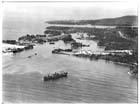The Huon Peninsula campaign began with the fall of Lae to the Australian 7th and 9th Divisions in September 1943. The 9th Division continued the coastal offensive, coming up against the Japanese 20th Division, which was brought forward from Bogadjim.
The first major objective for the Australians was Finschhafen. After landing north of the village, which also functioned as a forward supply base for the Japanese, on 22 September 1943, the Australians captured Finschhafen in early October and then moved against Sattelberg Mountain, the dominant feature overlooking the coast. A counter-attack by the Japanese 20th Division failed and, after some hard fighting, the Australians captured Sattelberg on 27 November.
After the fall of Sattelberg, the 9th Division was ordered to continue the advance towards Sio, on the northern end of the Huon Peninsula. With one brigade advancing through Wareo and Gusika in the hinterland, another moved along the coast. The Australians were better equipped and able to call on air support to assist their attacks. The 20th Division attempted to delay the Australians but suffered heavy casualties from fighting and sickness, with only about one-third of the troops remaining fit for action. The 9th Division’s final objective, Sio, fell on 15 January 1944.
Huon Peninsula:
 Overview text
Overview text Longer text
Longer text  Images
Images  KITAMOTO Misamichi
KITAMOTO Misamichi  Map
Map  SATÔ Hiromasa
SATÔ Hiromasa  Seabourne counter-attack
Seabourne counter-attackClick images to enlarge.

AWM 071959

AWM 016126
